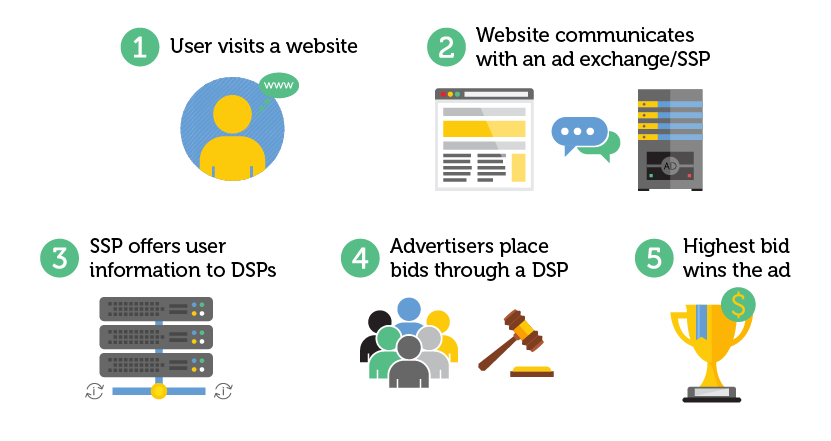[ad_1]
Understanding programmatic advertising can indeed be a complex task. Thus, we aim to clarify the distinctions among the three primary forms of programmatic advertising: Real-time Bidding, Private Marketplace, and Programmatic Direct.
How does real-time bidding work?

Real-Time Bidding is an automated auction process, allowing advertisers to compete for the opportunity to deliver personalized ads to their target consumers.
These ads are created based on a user’s browser cookies, reflecting their online history. This enables advertisers to more accurately target audiences who have shown interest in their offerings.
In making these bidding decisions, advertisers employ technology that merges data about the webpage and the user. Factors such as the webpage’s URL, its content category, the ad space location, and the user’s browser cookies all contribute to the determination of an ad’s value to the advertiser.
While Real-time bidding tends to be the most budget-friendly type of programmatic advertising, it provides the least amount of precision for both publishers and advertisers. Despite this, RTB is the largest form of programmatic advertising, serving billions of impressions daily. The majority of programmatic purchases occur here, given the vast number of advertisers vying for RTB inventory.
How do PMPs work?

Private Marketplace, or PMP, refers to an exclusive real-time bidding auction where one or several publishers invite a select group of advertisers to purchase their inventory.
In PMP deals, the advertiser eliminates intermediaries, bypassing exchanges and server-side platforms entirely. Advertisers can access premium sites at lower costs compared to programmatic direct, with the certainty of knowing exactly where their ads will be displayed.
Typically, PMPs are administered with an Insertion Order (IO), a contract detailing the inventory’s price and the ad’s duration.
Unlike fixed CPM models, the Cost per Mille (CPM) in PMPs is usually variable, meaning the advertisers don’t pre-agree on a CPM rate.
PMPs and Programmatic Direct each offer distinct benefits for publishers and buyers. Publishers gain better insight into who is serving ads on their sites, and they can command higher prices for their space. However, to justify the increased cost, buyers seek privileged access to the supply. Essentially, they aim to reach their target audience ahead of their competitors.
How does programmatic direct work?

Programmatic direct is slightly different to PMP deals. Programmatic Direct is direct-sold, guaranteed inventory, that unlike PMP deals doesn’t require human intervention to run.
However, Programmatic Direct is actually a more manual process than PMP deals.
This is because deals are made on an individual basis, where a publisher’s sales rep negotiates the arrangement with the advertiser on a one-to-one basis.
With Programmatic Direct, the advertiser purchases a fixed CPM, meaning the advertiser agrees to paid a predetermined CPM.
Programmatic Direct is a good choice for brands focused on brand safety, as the relationship is one-to-one and the brands know exactly where their ads will appear.
A metaphor for understanding the difference between RTB, PMPs and programmatic direct
So to summarize, here’s a way to conceptualize the flow from Open RTB to PMP to direct.
The open market (RTB) has thousands of advertisers and millions of sites in it. When buyers are looking for very specific people, that’s difficult. Think of a huge farmer’s market with thousands of farmers and thousands of buyers, and you’re a buyer looking for the perfect apples. You know you’re looking for big, green, organic, and ripe. You can find a good one, but the odds of you actually finding the perfect apple aren’t great.
So now you can pay extra to go into the VIP area where only the best apple farmers are, but the cheapest apple is $5. You can now find the apple you want, but you’re still competing with all the other buyers to find the one you want. At least your odds are better. This is equivalent to PMPs.
But you really want this perfect apple, and you know which farmer has it. He says he will give you the perfect apple for $10, but he will deliver it to your house and skip the farmer’s market and price haggling altogether. This is how programmatic direct works.
Advantages of Real-Time Bidding
For Advertisers: Real-time bidding (RTB) enables advertisers to make purchases more quickly and efficiently. They can exercise greater control over their purchases, reducing the number of irrelevant ad impressions, displaying ads to a relevant audience, and minimizing the risk of ad fraud, making it a profitable endeavor.
For Publishers: Utilizing real-time bidding through a Supply Side Platform (SSP) can assist publishers in identifying suitable demand sources to work with, considering factors such as latency, unique demand, bid ratios, and ad space availability. This grants publishers control over their inventory, dictating which advertisers can purchase and at what price.
[ad_2]









